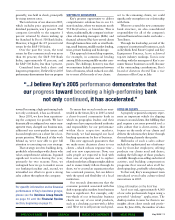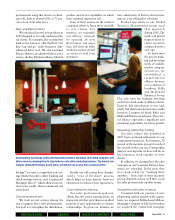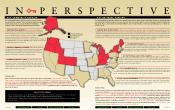KeyBank 2005 Annual Report Download - page 13
Download and view the complete annual report
Please find page 13 of the 2005 KeyBank annual report below. You can navigate through the pages in the report by either clicking on the pages listed below, or by using the keyword search tool below to find specific information within the annual report.
12
MANAGEMENT’S DISCUSSION & ANALYSIS OF FINANCIAL CONDITION & RESULTS OF OPERATIONS KEYCORP AND SUBSIDIARIES
INTRODUCTION
This section generally reviews the financial condition and results of
operations of KeyCorp and its subsidiaries for each of the past three
years. Some tables may include additional periods to comply with
disclosure requirements or to illustrate trends in greater depth. When you
read this discussion, you should also refer to the consolidated financial
statements and related notes that appear on pages 53 through 90.
Terminology
This report contains some shortened names and industry-specific terms.
We want to explain some of these terms at the outset so you can better
understand the discussion that follows.
•KeyCorp refers solely to the parent holding company.
•KBNA refers to KeyCorp’s subsidiary bank, KeyBank National
Association.
•Key refers to the consolidated entity consisting of KeyCorp and its
subsidiaries.
•A KeyCenter is one of Key’s full-service retail banking facilities or
branches.
• Key engages in capital markets activities. These activities encompass
a variety of products and services. Among other things, we trade
securities as a dealer, enter into derivative contracts (both to
accommodate clients’ financing needs and for proprietary trading
purposes), and conduct transactions in foreign currencies (both to
accommodate clients’ needs and to benefit from fluctuations in
exchange rates).
• All earnings per share data included in this discussion are presented
on a diluted basis, which takes into account all common shares
outstanding as well as potential common shares that could result from
the exercise of outstanding stock options and other stock awards.
Some of the financial information tables also include basic earnings
per share, which takes into account only common shares outstanding.
• For regulatory purposes, capital is divided into two classes. Federal
regulations prescribe that at least one-half of a bank or bank holding
company’s total risk-based capital must qualify as Tier 1. Both total
and Tier 1 capital serve as bases for several measures of capital
adequacy, which is an important indicator of financial stability and
condition. You will find a more detailed explanation of total and Tier
1 capital and how they are calculated in the section entitled “Capital,”
which begins on page 34.
Description of business
KeyCorp is one of the nation’s largest bank-based financial services
companies with consolidated total assets of $93.1 billion at December
31, 2005. KeyCorp’s subsidiaries provide a wide range of retail and
commercial banking, commercial leasing, investment management,
consumer finance, and investment banking products and services to
individual, corporate and institutional clients through two major
business groups: Consumer Banking, and Corporate and Investment
Banking. As of December 31, 2005, these services were provided across
much of the country through subsidiaries operating 947 KeyCenters, a
telephone banking call center services group and 2,180 ATMs, in
sixteen states. Additional information pertaining to KeyCorp’s two
business groups appears in the “Line of Business Results” section,
which begins on page 18, and in Note 4 (“Line of Business Results”),
which begins on page 64.
In addition to the customary banking services of accepting deposits and
making loans, KeyCorp’s bank and trust company subsidiaries offer
personal and corporate trust services, personal financial services, access
to mutual funds, cash management services, investment banking and
capital markets products, and international banking services. Through
its subsidiary bank, trust company and registered investment adviser
subsidiaries, KeyCorp provides investment management services to
clients that include large corporate and public retirement plans,
foundations and endowments, high net worth individuals and Taft-
Hartley plans (i.e., multiemployer trust funds established for providing
pension, vacation or other benefits to employees).
KeyCorp provides other financial services both inside and outside of its
primary banking markets through its nonbank subsidiaries. These
services include accident, health and credit-life insurance on loans
made by KBNA, principal investing, community development financing,
securities underwriting and brokerage, and other financial services.
KeyCorp also is an equity participant in a joint venture with Key
Merchant Services, LLC, which provides merchant services to businesses.
Long-term goals
Key’s long-term financial goals are to achieve an annual return on
average equity in the range of 16% to 18% and to grow earnings per
common share at an annual rate of 8% to 10%. Our strategy for
achieving these goals is described under the heading “Corporate
strategy” on page 14.
During 2005, Key’s earnings per common share grew by 19%. This
improvement was accomplished by growing revenue faster than expenses,
and also reflected a lower provision for loan losses. In addition, capital
that exceeds internal guidelines and minimum requirements prescribed
by the regulators can be used to repurchase common shares in the
open market. As a result of such repurchases, Key’s weighted-average
fully-diluted common shares decreased to 414,014,032 shares for 2005
from 415,430,345 shares for 2004. A lower share count also can
contribute to both earnings per share growth and improved returns on
average equity. Net share repurchase activity in 2005 did not have a
material effect on either of these profitability measures.
Forward-looking statements
This report may contain “forward-looking statements,” within the
meaning of the Private Securities Litigation Reform Act of 1995,
including statements about our long-term goals, financial condition,
results of operations, earnings, levels of net loan charge-offs and
nonperforming assets, interest rate exposure and profitability. These
statements usually can be identified by the use of forward-looking
language such as “our goal,” “our objective,” “our plan,” “will likely
result,” “expects,” “plans,” “anticipates,” “intends,” “projects,”
“believes,” “estimates” or other similar words or expressions or
conditional verbs such as “will,” “would,” “could” and “should.”
NEXT PAGEPREVIOUS PAGE SEARCH BACK TO CONTENTS
























